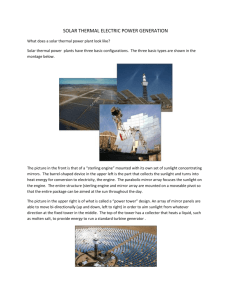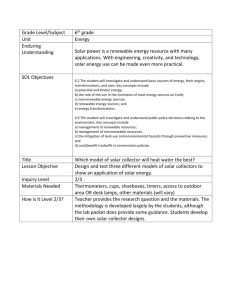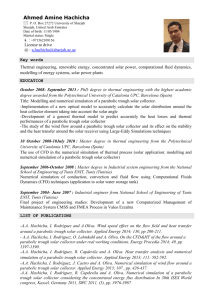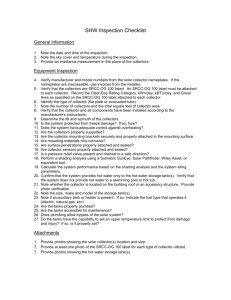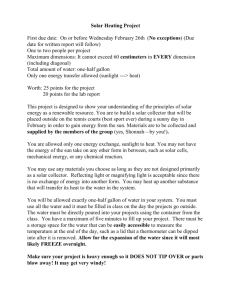1 - Rensselaer Hartford Campus - Rensselaer Polytechnic Institute
advertisement
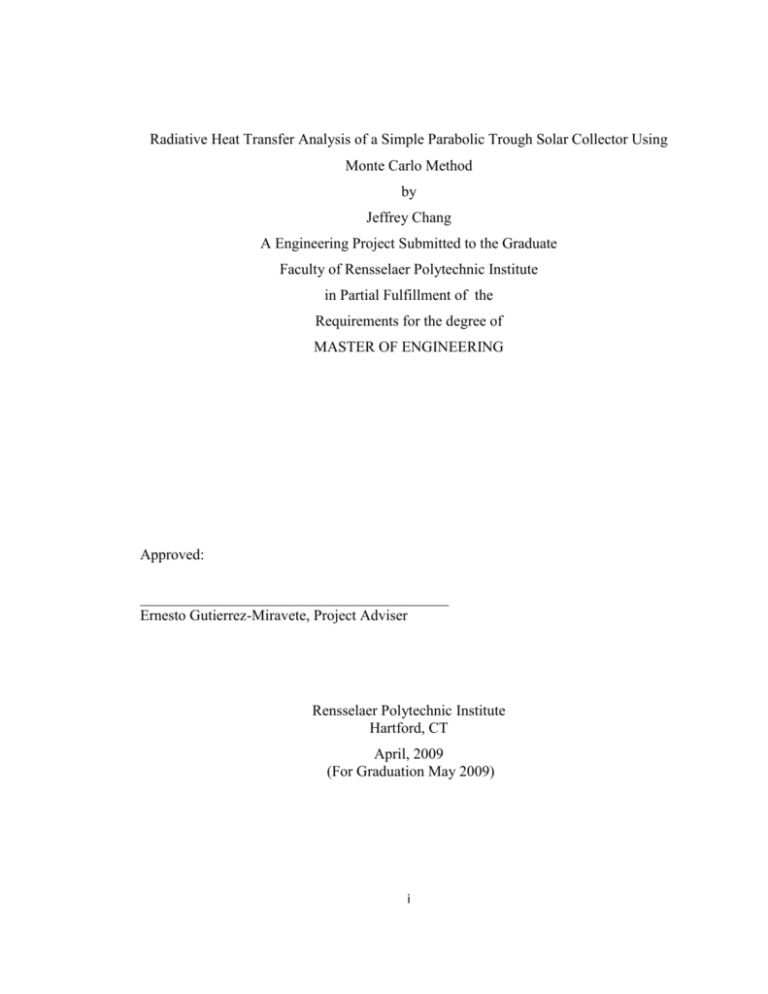
Radiative Heat Transfer Analysis of a Simple Parabolic Trough Solar Collector Using Monte Carlo Method by Jeffrey Chang A Engineering Project Submitted to the Graduate Faculty of Rensselaer Polytechnic Institute in Partial Fulfillment of the Requirements for the degree of MASTER OF ENGINEERING Approved: _________________________________________ Ernesto Gutierrez-Miravete, Project Adviser Rensselaer Polytechnic Institute Hartford, CT April, 2009 (For Graduation May 2009) i CONTENTS LIST OF SYMBOLS ........................................................................................................ iii LIST OF TABLES ............................................................................................................ iv LIST OF EQUATIONS ..................................................................................................... v LIST OF FIGURES .......................................................................................................... vi ACKNOWLEDGMENT ................................................................................................. vii ABSTRACT ................................................................................................................... viii Introduction........................................................................................................................ 2 Methodology ...................................................................................................................... 6 ii LIST OF SYMBOLS Theta Random-selected angle of photon from surface of collector H Target height (distance from bottom center of collector to middle of target) X1 Randomly-selected x-coordinate of photon emission Y1 Random y-coordinate of photon emission B1 Y-axis intercept of line equation expressing tangent line. PHI Angle of tangent line (relative to x-axis) R1 Radius of target R2 Radius of semi circular collector C Coefficient of parabolic function F1-2 Configuration Factor from surface 1 to surface 2. iii LIST OF TABLES Table 1: Comparison of Configuration Factors for “two perpendicular infinitely long plates” ................................................................................................................................ 8 Table 2: One-dimensional analysis of Beer’s Law (attenuated flight distances) ............ 10 Table 3: Efficiencies for a Semicircular Collector .......................................................... 13 Table 4: Comparison of efficiencies for parabolic and semicircular collectors. ............. 15 iv LIST OF EQUATIONS Equation 1: Configuration Factor for two infinitely long plates of unequal lengths ......... 7 Equation 2: Beer’s law....................................................................................................... 9 Equation 3: Random number representing arbitrary intensity........................................... 9 Equation 4 Flight distance for any photon using random number..................................... 9 Equation 5: Exact solution of absorption for any one interval ........................................ 10 Equation 6: Configuration Factor for Figure 7 ................................................................ 11 Equation 7: Configuration Factor reciprocity between two surfaces .............................. 11 Equation 8 ........................................................................................................................ 11 Equation 9: Areas of semi cylinder and circle of unit depth. .......................................... 11 Equation 10: Configuration factor of semi cylindrical to circular surfaces. .................... 11 v LIST OF FIGURES Figure 1: Central Solar tower with heliostats .................................................................... 2 Figure 2: Concentrating parabolic troughs ........................................................................ 3 vi ACKNOWLEDGMENT Type the text of your acknowledgment here. vii ABSTRACT Type the text of your abstract here. viii 1 Introduction Since 1900, more than 20 solar-collector designs have been tested and determined to be functional. They can be classified as either non-concentrating or concentrating solar collectors. Non-concentrating collectors typically come in the form of flat plate. On the other hand, concentrating collectors come in a variety of geometries including convex dish mirrors to semicylinder troughs. The downside to the flat-plate collector is that it incurs unrecoverable losses to its environment. Concentrating collectors, on the other hand, will focus the sun’s energy to a single point increasing its power flux and strength. Collectors have been used on a small scale for household power demand (environmental heating and electricity), they have been used in larger volume in solar electric generating systems (SEGs). One example of large-scale solar power generation uses a field of flat and movable reflecting mirrors called heliostats to concentrate the sun’s energy onto a receiving target on a central tower. This plant type is called a solar “central tower plant.” The tower contains a water boiler to which uses the energy to generate steam to drive a turbine. A 10MW facility called Solar Two operated in Barstow, California from 1996 to 1999 until it was decommissioned as other plants were being developed. Figure 1: Central Solar tower with heliostats 2 Figure 2: Concentrating parabolic troughs The other class of large scale concentrating solar energy generating plant implements parabolic troughs which is the focus of discussion in this document. The functional solar collecting unit of these SEGs is called a simple parabolic trough solar collector (SPC). It’s called a trough is fitting as the wide parabolic mirror resembles a container for animal feed. In this case, a trough receives, reflects, and concentrates the sun’s rays onto a pipe carrying heat transfer fluids (commonly oil) to a heat-exchanger. Depending upon the setup, the concentration of the sun’s rays can be magnified up 60 times its original light intensity. The heat exchanger will then generate high-pressure steam powering a turbine generator making energy available. The diagram below shows the basic design of a parabolic solar collector. The curved geometry is designed such that solar energy will be reflected and concentrated on the point where the pipe is positioned. The collector or mirror can be extremely effective in increasing the power flux of the solar energy as it reflects the rays. 3 Fluid in pipe Solar energy Parabolic mirror Figure 3: Schematic of parabolic collector Currently, the world’s largest SEG called (MSP-1) Mojave Solar Park is under development in the Mojave Desert. It has a 553 MW capacity and will take up 9 square miles of space. Figure 4: Schematic of Solar Electric Generating plant A downside to solar energy is the obvious limited time frame of the sun’s presence during the day. At night, natural gas is typically used as backup power reserve to drive the system. That is why large electricity plants are planned in the southwestern states. The drawbacks to solar collectors is that the nature of the geometry must track to the sun to optimize efficiency. At high noon, the sun will be directly above the earth sending rays at a concentrated and perpendicular angles. In most parts of the country (especially the northeast) the 4 prominent weather conditions resulting in habitual cloud-covered skies do not provide optimal conditions for harnessing solar energy. The purpose of this engineering project is to investigate and validate the Monte Carlo method in calculating the efficiency of a simple parabolic solar collector. Thermal radiation is a significant component of the heat transfer within this apparatus so it is relevant that the efficiency of this solar collector be understood. Results from this approach would be compared to the analytical solution for first the semicircular geometry and then applied to the parabolic geometry. Later, a parametric study of the parabolic solar collector and pipe diameter size and shape will be investigated to understand the optimization of efficiency. The goal is to research for, edit, and implement numerical code for the computer to solve. FORTRAN compilers would be used to run and output results of the code. 5 Methodology Discuss Monte Carlo Method The Monte Carlo Method is a general statistical approach to modeling physical problems using a sample random numbers. The methodology is useful in approximating solutions to many problems. Using a random number generator a sample of inputs or data (be it number of people living in cities, darts thrown at a board) can be produced for analysis. If this sample is large enough, we produce a probability distribution reflecting reality. It can be analogous to a game of darts where the player has a significantly large number of darts to play with. Assume that the objective of the game is not competitively play to achieve the best score but rather to randomly cast darts toward the target and count the number that hit a particular region versus the number that miss. If the number of darts cast is large enough, we can obtain a probability distribution that best represents. For purpose of calculating configuration factors in radiation heat transfer, imagine that a collection of photons leaving one surface and hitting a secondary surface (hence a target). The efficiency and hence configuration factor would be calculated by the number of photons that hit the surface divided by the total number of photons emitted. To begin, a combination of FORTRAN codes and spreadsheets will be used to investigate a few related straightforward problems. The MC approach will be validated with the related equations. Later on, other assumptions will be introduced and parametric studies conducted to answer the question about finding the optimal Case 0: Configuration Factor for Two Infinitely Long Planes We will take a first look into a hit-or-miss the target example for a simple configuration factor problem to observe the accuracy of the Monte Carlo Method approximation. Let’s assume a sample of 100,000 (NRAY) photons are emitted from surface A1 and at random angles. The efficiency will be calculated as the number photons that strike A2 divided by the total number of 6 photons emitted. From Siegel and Howell’s reference Catalog of the Configuration Factors the view factor for two perpendicular infinitely long plates of unequal widths is expressed as: Figure 5: Schematic of two infinitely long plates of unequal lengths F12 1 1 H 1 H 2 2 where H= h/w Equation 1: Configuration Factor for two infinitely long plates of unequal lengths For simplicity assume that W= 1 unit length and vary h from 0 to 0.9. The FORTRAN 77 program calls random numbers for two variables including X1 and THETA. X1 determines the location of photon emission along the x-axis [0,1] while THETA [0,PI] determines the random angle that the photon emits at relative to the x-axis. The logic for counting the hits is determined by whether or not the y-intercept of the flight path lies between 0 and h. The following table lists the analytical values compared to Monte Carlo Method FORTRAN program configuration factors. 7 H 0.1 0.2 0.3 0.4 0.5 0.6 0.7 0.8 0.9 1 MC_EFF Analytical % error 0.04533 0.04751 4.58% 0.08870 0.09010 1.55% 0.12711 0.12798 0.68% 0.16059 0.16148 0.55% 0.19027 0.19098 0.37% 0.21710 0.21690 -0.09% 0.24032 0.23967 -0.27% 0.26026 0.25969 -0.22% 0.27819 0.27732 -0.31% 0.29363 0.29289 -0.25% Table 1: Comparison of Configuration Factors for “two perpendicular infinitely long plates” At h=0.1, there is noticeably more error than at other heights. But at these other values of h, the Monte Carlo can approximate the view factor within 1%. These results confirm that MC is a reasonable approximation for the configuration factor of 2-D geometry extending infinitely. Attenuation of Photon Flight Initially the assumption of infinite photon flight distances is considered for the first models presented. But in reality, photons will travel finite distances since they will eventually be absorbed by gaseous media according to Beer’s Law (equation 2). As photons travel in distance, it is inevitable that they will lose light intensity. Equation 2 expresses Beer’s Law as an exponential decaying function of x or distance. The Monte Carlo Method can also be used to approximate this absorption rate. To do this, another sample of random numbers is required to create a population of photon flight distances. 8 Figure 6: Photons absorbed by gaseous medium and logarithmic decay observed. 1 - e -S = I 0 - I I0 where, I0 is initial photon intensity I is attenuated intensity of photon S is the finite flight distance of the photon Equation 2: Beer’s law R s = 1 - e -S Equation 3: Random number representing arbitrary intensity S= - ln(1 - R s ) AK Equation 4 Flight distance for any photon using random number Using Beer’s law we determine the attenuation of light intensity of each photon. Since this a fraction, any random numbers between 0 and 1 can be substituted in its place. From each random attenuated light intensity or Rs, we can calculate a flight distance for a photon. Note that an absorption coefficient (AK) is applied. The higher the absorption coefficient, the more absorption occurs as flight distance (S) decreases. Yang and Taniguchi have developed the original FORTRAN code to approximate the absorption of photons using the Monte Carlo method. This analysis will be replicated in the following chart. Assume that a wall target is 10 in. away from the point of photon emission. Equation 3 uses the Monte Carlo method. We can observe how many photons are absorbed at 1 in/in. intervals. These results will also be compared to the exact solution. 9 Absorption coefficient (AK) # photons (N) 0.1 100000 Distance (in/in) # photons absorbed 1 2 3 4 5 6 7 8 9 10 Total Absorption 9348 864 2 7 741 7056 6396 5851 5267 4717 4336 3975 63.33% MC Cal culated Absorption 9.35% 8.64% 7.74% 7.06% 6.40 % 5.85% 5.27% 4.72% 4.34% 3.98% 63.33% Exact Absorption 9.52% 8.61% 7.79% 7.05% 6.38 % 5.77% 5.22% 4.73% 4.28% 3.87% 63.21% %error -1.8% 0.4% -0.6% 0.1% 0.3% 1 .4% 0.8% -0.2% 1.4% 2.7% 0.2% Table 2: One-dimensional MC analysis of Beer’s Law (attenuated flight distances) Sexact = e -AK(x -1) e -AKx Equation 5: Exact solution of absorption for any one interval Assuming AK=0.1 and N=100000, the total absorption of photons is 63% before reaching the wall target. Over all the intervals, the Monte Carlo approximation comes within 2% of the exact solution. This further confirms that Monte Carlo can be used to apply attenuation of the photon flight path in later analyses. Case 1: Semicircular Collector Now we will baseline the solution of a solar collector with the analytical results for a semicircular geometry with the same assumptions as in Case 0. Assumptions: a) Random emitting location b) Random reflection angle c) Infinite photon flight distance d) N=100,000 photons chosen From Howell’s Catalog of Configuration Factors, we can reference the analytical solution for the “exterior of infinitely long cylinder to interior of concentric semi cylinder.” The diagram below 10 indicates the value being independent of size or dimension but dependent upon the geometry. In applying this model, the infinitely long cylinder (A1) can be considered the pipe or the target while the concentric semi cylinder (A2) would be considered the emitting collector. We would like to calculate the configuration factor (F21) for the surface A2 emitting to A1. This can be calculated by reciprocity. Figure 7: Exterior of an infinitely long cylinder to interior of concentric semi cylinder. (Siegel and Howell) F1 2 1 2 Equation 6: Configuration Factor for Figure 7 A2 F21 A1 F12 Equation 7: Configuration Factor reciprocity between two surfaces F21 A1 F12 A2 Equation 8: A1 2 r1 A2 r2 Equation 9: Areas of semi cylinder and circle of unit depth. F21 2 r1 F12 r2 F21 r1 r2 Equation 10: Configuration factor of semi cylindrical to circular surfaces. 11 In the aforementioned proof, we immediately find that the configuration factor F2-1 is proportional to the size of the target. But there is a limit for this size. If the target gets too large, it will block the path of the sun’s radiation traveling to the collector making it impossible to concentrate the sun’s rays. Thus R1 should not be greater than R2. In the FORTRAN code, a parametric study varying the radii of the collector and target is shown below. As in Case 0, a sample size of 100,000 photons is used for the MC analysis. For simplicity, assume that R1/R2 varies from 0.1 to 1, the height H of the target is fixed to 1. It is assumed that the photon emission location lies between x = [-1,1]. The angle of emission (theta) is relative to the line tangent to the point of emission X1. Phi is the angle between the x-axis and tangent line. To find the slope of the photon path line equation, we figure out trigonometrically by adding phi and theta to get the angle with reference to the x-axis. The logic for hitting the circle R1 is whether or not the line equation expressing the photon flight path intercepts with the equation expressing the circle 1. All other photons not qualifying this condition are considered misses. Figure 8: Semicircular Collector Schematic 12 R1/R2 0.1 0.2 0.3 0.4 0.5 0.6 0.7 0.8 0.9 1 efficiency 0.0997 0.2009 0.3005 0.4005 0.5007 0.6001 0.7001 0.8011 0.9005 0.9999 %error -0.33% 0.42% 0.15% 0.13% 0.14% 0.02% 0.02% 0.13% 0.06% -0.01% Table 3: Efficiencies for a Semicircular Collector Configuration Factor for Semicircle Geometry R1/R2 100 0.1 90 0.2 80 0.3 70 EFficiency % 0.4 60 0.5 50 0.6 40 0.7 30 0.8 20 0.9 10 1 0 0 0.1 0.2 0.3 0.4 0.5 0.6 0.7 0.8 0.9 1 1.1 1.2 R1/H Figure 9: Efficiencies for a semicircular collector (parametric study varying height (H) of target) As calculated analytically, the efficiency of a semicircular collector is equivalent to the ratio R1/R2 within a reasonable amount of error (less than 0.5%) confirming that the MC method is validated. The next chart above goes further to show the effect of changing the height H of the circular target. This parametric study lists the various ratios of the radius of the target to the height of the circle R1/H. It is obvious that the bounds of R1/H cannot be greater than 1 or the 13 target would encompass the collector. From the chart, it does not appear that the efficiency is dependent upon this variable. We can move on to the next model where an actual parabolic geometry is examined. Case 2: Parabolic Collector The same four assumptions will be applied to the parabolic collector. (Random emitting location, random reflection angles, and infinite flight distances.) But this time, the parabolic shape invokes another variable to examine. The coefficient C determines the profile width of the parabola. For simplicity, we will set some initial inputs. Random emitting locations along the parabola range from x = [-1,1]. R1 is varied from 0.1 to 1, with C=1, and H=1. Parabolic Collector - Geometric Profiles 2 C=0.25 C=1.0 C=2.0 1.5 1 R1 H 0.5 0 -1 -0.75 -0.5 -0.25 0 0.25 0.5 0.75 1 X-min X-max -0.5 Figure 10: Schematic of parabolic collector geometries (C=0.25, 1.0, 2.0) -1 When compared to efficiency values from the semicircular mirror study there is approximately a 5% improvement for a parabolic mirror as shown in the table below. This confirms the fact that parabolic solar collectors are preferable and commonly used in practice. 14 R1 0.1 0.2 0.3 0.4 0.5 0.6 0.7 0.8 0.9 1 efficiency of parabolic 0.10512 0.21111 0.31723 0.42235 0.52786 0.63391 0.73921 0.84536 0.94532 0.99995 efficiency of semicircle 0.0997 0.2009 0.3005 0.4005 0.5007 0.6001 0.7001 0.8011 0.9005 0.9999 % difference 5.18% 4.86% 5.29% 5.16% 5.15% 5.33% 5.29% 5.24% 4.74% 0.00% Table 4: Comparison of efficiencies for parabolic and semicircular collectors (C=1, H=1). Next, we will reapply the same parametric study done in Case 1 to find the optimal placement for each target size. The target height H range is [0.1, 1] for the case where C=1. The following chart plots efficiencies for target sizes R1=[0.1,1] against the parameter H/C. The results indicate that the max efficiency shifts to the right as R1 increases. It appears that the max efficiency occurs at H/C=R1 (for R1=0.6, peak efficiency is found at H/C=0.6). For other values of C plotted in the later figures, peak efficiencies are found at values where H/C=R1/C (in Figure X, peak efficiency for R1=1.0 is found at H/C=0.5). If we introduce finite photon flight distances using Beer’s law, the max efficiency curves shifts to the left as expected. The attenuation of the photon flight distance will decrease the chances of. Assuming that the point of emission can be taken between x = [-1,1]. Finding the point of maximum efficiency relative to all target sizes ranges from H/C= 0.1 for R1=0.1 to H/C=0.7 for R1=1. 15 Parametric study for parabolic collector H= [0.1,1.0], C=1 (Infinite Flight) 110 100 R1 90 0.1 0.2 0.3 0.4 0.5 0.6 0.7 0.8 0.9 1 80 EFficiency % 70 60 50 40 30 20 10 0 0 0.1 0.2 0.3 0.4 0.5 0.6 0.7 0.8 0.9 1 1.1 H/C Figure 11: Efficiencies for parabolic collector with photons of infinite flight. C=1, H=[0.1,1.0] Parametric study for parabolic collector H= [0.01,1.81], C=2 (Infinite Flight) 100 R1 90 0.1 80 0.2 EFficiency % 70 0.3 0.4 60 0.5 50 0.6 40 0.7 0.8 30 0.9 20 1 10 0 0 0.1 0.2 0.3 0.4 0.5 H/C 0.6 0.7 0.8 0.9 1 Figure 12: Efficiencies for parabolic collector with photons of infinite flight. C=2, H=[0.2,2.0] 16 Parametric study for parabolic collector H= [0.05, 0.55], C=0.25 (Infinite Flight) 110 100 R1 90 0.1 0.2 0.3 0.4 0.5 0.6 0.7 0.8 0.9 1 80 EFficiency % 70 60 50 40 30 20 10 0 0 0.1 0.2 0.3 0.4 0.5 0.6 0.7 0.8 0.9 1 1.1 1.2 1.3 1.4 1.5 1.6 1.7 1.8 1.9 2 2.1 H/C Figure 13: Efficiencies for parabolic collector with photons of infinite flight. C=0.25, H=[0.05,0.55] Parametric study for parabolic collector H= [0.01,0.91], C=1 (Finite Flight) 80 70 R1 0.1 0.2 0.3 0.4 0.5 0.6 0.7 0.8 0.9 1 60 EFficiency % 50 40 30 20 10 0 0 0.1 0.2 0.3 0.4 0.5 H/C 0.6 0.7 0.8 0.9 1 Figure 14: Efficiencies for parabolic collector with photons of finite flight. C=1, H=[0.1,1.0] 17 Parametric study for parabolic collector H= [0.01,0.46], C=0.25 (Finite Flight) 100 90 R1 80 0.1 0.2 0.3 0.4 0.5 0.6 0.7 0.8 0.9 1 EFficiency % 70 60 50 40 30 20 10 0 0 0.1 0.2 0.3 0.4 0.5 0.6 0.7 0.8 0.9 1 1.1 1.2 1.3 1.4 1.5 1.6 1.7 1.8 1.9 2 H/C Parametric study for parabolic collector H= [0.01,1.81], C=2 (Finite Flight) 70 R1 60 0.1 50 0.2 EFficiency % 0.3 0.4 40 0.5 0.6 30 0.7 0.8 0.9 20 1 10 0 0 0.1 0.2 0.3 0.4 0.5 H/C 0.6 0.7 0.8 0.9 1 Parabolic Collector with Finite Flight Distance – Third Model 18 The next step is to implement the attenuated flight of photons to the parabolic geometry via Beer’s Law as discussed in the beginning. Date Milestone 1/28/2009 Post Project Proposal 2/4/2009 Analysis of Beer's Law 1-D analysis (BEER) 2/11/2009 Analysis of absorption in 2-D gasesous medium (RAT1) 2/18/2009 Submit 1st Progress Report 2/25/2009 Research fundamentals of absorption in medium 3/4/2009 Augment 2-D fortran program for geometry (RAT1) 3/11/2009 Submit 2nd Progress Report 3/18/2009 Vary misc parameters (gas absorption, geometry?) 3/25/2009 Write and compare results 4/1/2009 Write and compare results 4/8/2009 Prepare Final Report 4/15/2009 Final Report Due 19 References: McAdams, William H.; Heat Transmission, McGraw-Hill 3rd Edition 1954 Ch 4 Kersch, A., Morokoff, W.; Radiative Heat Transfer with Quasi Monte Carlo Methods, Simulation of Semiconductor Devices and Processes Vol 5. Sept 1993 Knaus, H., Schneider, R.; Comparison of Different Radiative Heat Transfer Models and their Applicability to Coal-Fired Utility Boiler Simulations, University of Stuttgart Howell, J.R., The Monte Carlo Method in Radiative Heat Transfer, Journal of Heat Transfer (ASME), August 1998 Vol. 120 pp. 547-560 Forristal, R.; Heat Transfer Analysis and Modeling of a Parabolic Trough Solar Receiver Implemented in Engineering Equation Solver, National Renewable Energy Laboratory Technical Report, October 2003 Hottel, Hoyt C., Sarofim, Adel F., Radiative Transfer, McGraw-Hill Book Company, Siegel, Robert, Howell, John, Thermal Radiation Heat Transfer 4th Edition, Taylor and Francis,2002 Howell, John R.; Buckius, Richard O.; Fundamentals of engineering thermodynamics, McGraw 20 Hill, 1992 Saltiel, C.; Naraghi, M. H. N.; Radiative configuration factors from cylinders to coaxial axisymmetric bodies, International Journal of Heat and Mass Transfer, Vol. 33, Jan. 1990, p. 215-218 Yang, Wen-Jei; Taniguchi, Hiroshi; Kudo, Kazuhiko; Radiative Heat Transfer by the Monte Carlo Method,. Advances in Heat Transfer, Academic Press, Vol. 27, 1995 http://www1.eere.energy.gov/solar/sh_basics_collectors.html 21
